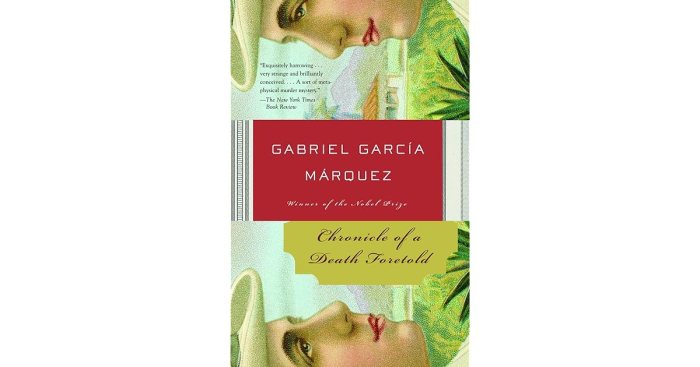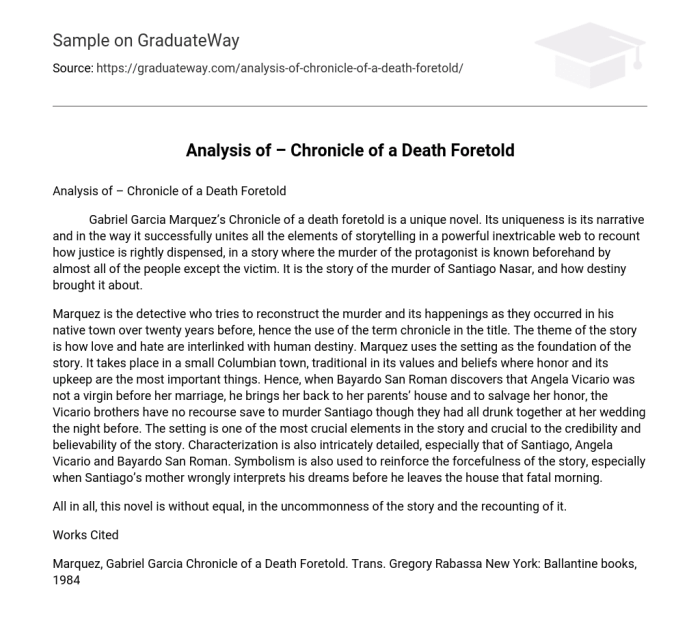Literary devices in Chronicle of a Death Foretold, a masterpiece by Gabriel García Márquez, are the threads that weave together a complex and haunting tapestry. From foreshadowing to irony, these devices immerse readers in the novel’s intricate narrative, enhancing characterization, setting, and the exploration of profound themes.
Foreshadowing casts an ominous shadow over the story, building suspense and creating an atmosphere of inevitability. Symbols, such as the butterflies and the rain, resonate throughout the novel, adding layers of meaning to characters and events. Vivid imagery transports readers into the sweltering heat and oppressive atmosphere of the Colombian town, intensifying the emotional impact of the narrative.
Foreshadowing

Foreshadowing is a literary device that hints at events that will occur later in the story. In Chronicle of a Death Foretold, foreshadowing is used extensively to create suspense and build tension. For example, the novel begins with the statement that Santiago Nasar will be killed, and the rest of the novel is a detailed account of the events leading up to his death.
This foreshadowing creates a sense of inevitability and doom, and it makes the reader eager to find out how and why Santiago will be killed.
Another example of foreshadowing in the novel is the description of the knives that will be used to kill Santiago. The knives are described as being “long and sharp,” and they are said to be “gleaming in the sunlight.” This description foreshadows the violence that will take place later in the novel, and it also suggests that Santiago’s death will be a deliberate and brutal act.
Symbolism
Symbolism is a literary device that uses objects, characters, or events to represent abstract ideas or concepts. In Chronicle of a Death Foretold, symbolism is used to enhance the novel’s themes and character development. For example, the color white is often associated with purity and innocence, and it is used to symbolize Santiago’s innocence and vulnerability.
The color red is often associated with violence and passion, and it is used to symbolize the violence that will take place later in the novel.
Another example of symbolism in the novel is the use of the wind. The wind is often described as being “hot” and “oppressive,” and it is used to symbolize the tension and violence that is building in the town. The wind also foreshadows the hurricane that will destroy the town at the end of the novel.
Imagery
Imagery is a literary device that uses sensory details to create a vivid picture in the reader’s mind. In Chronicle of a Death Foretold, imagery is used to contribute to the novel’s atmosphere and emotional impact. For example, the novel is filled with descriptions of the sights, sounds, and smells of the town.
These descriptions help to create a sense of place and time, and they also help the reader to experience the events of the novel more fully.
One example of imagery in the novel is the description of the town square on the day of Santiago’s murder. The square is described as being “crowded with people,” and the air is filled with the “sound of music and laughter.”
This description creates a sense of festivity and excitement, but it also foreshadows the violence that will take place later in the day.
Irony
Irony is a literary device that uses words or situations to create a contrast between what is expected and what actually happens. In Chronicle of a Death Foretold, irony is used to add depth and complexity to the story. For example, the novel is full of characters who are unaware of the events that are about to take place.
This irony creates a sense of suspense and tension, and it also makes the reader question the characters’ motives and actions.
One example of irony in the novel is the fact that Santiago is killed by the Vicario brothers, who are his friends and neighbors. This irony adds depth to the story, because it shows that even the most trusted people can be capable of violence.
Characterization

Characterization is a literary device that creates and develops characters. In Chronicle of a Death Foretold, characterization is used to portray the complex and flawed characters of the novel. The novel’s characters are described in great detail, and their motivations and actions are carefully explored.
This characterization helps the reader to understand the characters and their roles in the story.
One example of characterization in the novel is the portrayal of Santiago Nasar. Santiago is described as being a “handsome and charming” young man, but he is also shown to be arrogant and reckless. This characterization helps the reader to understand why Santiago is both admired and disliked by the people in his town.
Setting
Setting is a literary device that describes the time and place in which a story takes place. In Chronicle of a Death Foretold, the setting is used to create a sense of atmosphere and to enhance the novel’s themes. The novel is set in a small town in Colombia, and the town’s oppressive heat and poverty are described in great detail.
This setting helps to create a sense of tension and violence, and it also foreshadows the tragic events that will take place later in the novel.
Another example of setting in the novel is the use of the river. The river is described as being a “dark and dangerous” place, and it is used to symbolize the violence and danger that is present in the town.
The river also foreshadows the hurricane that will destroy the town at the end of the novel.
Point of View
Point of view is a literary device that determines who tells a story. In Chronicle of a Death Foretold, the novel is told from the point of view of an unnamed narrator who is present in the town during the events of the novel.
This narrator is able to provide a detailed account of the events that take place, but he is also limited by his own perspective. This point of view helps to create a sense of mystery and suspense, and it also allows the reader to question the reliability of the narrator.
One example of point of view in the novel is the use of the first-person plural. The narrator often uses the first-person plural to describe the events of the novel. This point of view helps to create a sense of community, and it also makes the reader feel like they are part of the story.
Theme

Theme is a literary device that explores a universal truth or idea. In Chronicle of a Death Foretold, the novel explores the themes of honor, violence, and fate. The novel shows how honor can lead to violence, and how violence can lead to tragedy.
The novel also explores the idea of fate, and how it can play a role in human lives.
One example of theme in the novel is the theme of honor. The novel shows how honor is important to the people in the town, and how it can lead to violence. For example, the Vicario brothers kill Santiago because they believe that he has dishonored their sister.
This act of violence shows how honor can lead to tragedy.
Popular Questions: Literary Devices In Chronicle Of A Death Foretold
How does foreshadowing contribute to the suspense in Chronicle of a Death Foretold?
Foreshadowing creates a sense of impending doom by hinting at future events. It builds tension and keeps readers on the edge of their seats, eagerly anticipating the unfolding tragedy.
What is the significance of the butterflies in the novel?
The butterflies symbolize beauty, fragility, and transformation. Their presence foreshadows the impending death of Santiago Nasar and highlights the fleeting nature of life.
How does the use of imagery enhance the atmosphere of the novel?
Vivid imagery transports readers into the sweltering heat and oppressive atmosphere of the Colombian town. It creates a sensory experience that intensifies the emotional impact of the narrative, making readers feel as if they are present in the story.